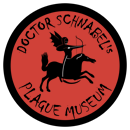
1. They weren’t doctors
Sometimes they were. But often they were fortuneseekers with little medical experience who took their chance after the real doctors had fled the city. They were hired by city councils to examine the sick and treat them when needed or have them sent to a plague hospital. Their rewards could be high, and sometimes they were allowed to establish themselves as medical practitioners after the epidemics, that is, if they survived.
2. They didn’t exist
Well, they did exist, but they didn’t look like the iconic prints from the 17th century. That’s because these are prints from the 17th century (and not documentary photos). They are meant to tell us something about the morals and beliefs of the people – not about their clothes.

3. The costume was based on antique ideas about the principles of contagion
These ideas were about the balance of bodily fluids, the planets, malignant air and invisible seeds. Still, the costume might have worked. High boots could offer protection against fleabites, as the use of leather gloves would do. A long robe with a closed hood and eyeglasses could form a defense against the airborne variant of the plague to some extent, especially if the wearer complied with social distancing as well. But (see 2.) wearing even a partial anti-plague suit has always been the exception rather than the rule.
4. Any plague worker could wear PPE, not just doctors
Nurses, priests, corps bearers, transporters, policemen – all of these are known to have worn some pieces of protective garment at some point in time. Most of all it was the employees that disinfected houses and belongings with smoke who wore protective clothes, including gloves and glasses. Alas, we have no pictures of them.
5. The mythbusters bust only part of the myth
A whole bunch of mythbusters has concluded that masked plague doctors did not appear before the 17th century. It is true that there have been plague workers in Italy and France in the 17th century who wore long robes and masks as well as hoods, yet not the beaky kind. The herbs and odorous substances were applied directly in the nose (and the mouth, and the ears). And there were sponges soaked in vinegar. A lot. From the Middle Ages until far in the 19th century. We have never seen these displayed in a plague exhibition though. That’s why we initiated the Plague Museum.


